A PDCA-Based Decision-Making Framework for Sustainable Marketing Communication Strategies: A Case Study of a Slovak Telecommunications Company
Abstract
1. Introduction
2. Literature Review
2.1. Marketing Communication in Large Telecommunication Companies
2.2. Marketing Communication Mix
2.3. Decision-Making in Sustainable Communication Marketing
2.4. Research Objectives and Hypothesis
3. Materials and Methods
3.1. Research Procedure, Problem, Research Questions and Hypothesis
3.2. First Phase of Research
3.3. Secondary Data Collection and Analysis
3.4. Second Phase of Research
3.5. Reliability and Validity of the Study
4. Results
4.1. Analysis of the Communication Mix Tools Used by the Largest Telecommunication Service Providers in Slovakia
4.2. The Result of a Questionnaire Survey Focused on the Influence of Communication Channels on the Customers of the Selected Company
5. Discussion
5.1. Summary and Interpretation of Findings
5.2. Implications of This Study and Proposed Guidance
5.3. Limitations and Suggestions for Future Research
6. Conclusions
Author Contributions
Funding
Data Availability Statement
Conflicts of Interest
References
- Alsaqer, S.; Katar, I.M.; Abdelhadi, A. Investigating TQM Strategies for Sustainable Customer Satisfaction in GCC Telecommunications. Sustainability 2024, 16, 6401. [Google Scholar] [CrossRef]
- Kita, J. Marketing; IURA EDITION: Bratislava, Slovakia, 2010; ISBN 978-80-8078-327-3. [Google Scholar]
- Chowdhury, R.H. Sentiment analysis and social media analytics in brand management: Techniques, trends, and implications. World J. Adv. Res. Rev. 2024, 23, 287–296. [Google Scholar] [CrossRef]
- George, B.; Paul, J. (Eds.) Digital Transformation in Business and Society: Theory and Cases; Springer International Publishing: Cham, Switzerland, 2020; ISBN 978-3-030-08276-5. [Google Scholar]
- Jeswani, R. The Role and Importance of Social Media Marketing in Brand Building. Ir. Interdiscip. J. Sci. Res. 2023, 7, 1–9. [Google Scholar] [CrossRef]
- Kaur, T. Online Marketing Communication. Biz Bytes 2017, 8, 132–137. [Google Scholar]
- Koman, G.; Kubina, M.; Holubčík, M.; Soviar, J. Possibilities of Application a Big Data in the Company Innovation Process. In Knowledge Management in Organizations; Uden, L., Hadzima, B., Ting, I.-H., Eds.; Communications in Computer and Information Science; Springer International Publishing: Cham, Switzerland, 2018; Volume 877, pp. 646–657. ISBN 978-3-319-95203-1. [Google Scholar]
- Dekay, S.H. How Large Companies React to Negative Facebook Comments. Corp. Commun. Int. J. 2012, 17, 289–299. [Google Scholar] [CrossRef]
- Kubenka, M. Prosperity Prediction in Czech Manufacturing Industries. Eng. Econ. 2018, 29, 516–525. [Google Scholar] [CrossRef]
- Kubenka, M. Predictive Ability of the Index of Creditworthiness. In Proceedings of the 7th International Scientific Conference Finance and Performance of Firms in Science, Education and Practice; Univerzita Tomáše Bati ve Zlíně:; Zlín, Czech Republic, 2015; pp. 795–804. ISBN 978-80-7454-482-8. [Google Scholar]
- Honková, I.; Myšková, R. Techniques, Objectives and Motivations of Creative Accounting: Evidence from the Czech Republic. Natl. Account. Rev. 2024, 6, 333–351. [Google Scholar] [CrossRef]
- Pernica, B.; Fuka, J.; Baťa, R.; Zdražil, P. Nervi Rei Publicae: Local Governments as Economic Populists? Policy Stud. 2025, 46, 628–651. [Google Scholar] [CrossRef]
- Fernández-Souto, A.B.; Puentes-Rivera, I.; Vázquez-Gestal, M. The Communicative Management of Large Companies in Spain: Structure, Resources and Main Challenges of Those Managers. Commun. Soc. 2019, 32, 161–177. [Google Scholar] [CrossRef]
- Šalgovičová, J.; Šalgovičová Ferriero, J. New Trends in Marketing and Communication in the Italian Banking Sector. Mark. Identity 2017, 247–254. [Google Scholar]
- Marčeková, R.; Malachovský, A. Nové Trendy v Marketingovej Komunikácii Podnikov Cestovného Ruchu Ako Faktor Regionálneho Rozvoja. In Proceedings of the XVIII. mezinárodní kolokvium o regionálních vědách. Sborník příspěvků. 18th International Colloquium on Regional Ciences. Conference Proceedings; Masarykova Univerzita: Brno, Czech Republic, 2015; pp. 713–721. [Google Scholar] [CrossRef]
- Grančičová, K.; Hrušovská, D. Tradičné Nástroje Verzus Nové Formy a Trendy v Marketingovej Komunikácii Podnikov Na Slovensku. Trendy V Podn. 2015, 5, 3–12. [Google Scholar]
- Sousa Filho, J.; Wanderley, L.; Lucian, R.; Kooy, K. Comunicação Da Responsabilidade Social Empresarial Em Websites Corporativos: Estudo Comparado Com Grandes Empresas de Países Emergentes. Rev. Gest. Ambient. Sustentabilidade 2014, 3, 122–134. [Google Scholar] [CrossRef]
- Capriotti, P.; Moreno, Á. Corporate Citizenship and Public Relations: The Importance and Interactivity of Social Responsibility Issues on Corporate Websites. Public Relat. Rev. 2007, 33, 84–91. [Google Scholar] [CrossRef]
- Arvidsson, S. Communication of Corporate Social Responsibility: A Study of the Views of Management Teams in Large Companies. J. Bus. Ethics 2010, 96, 339–354. [Google Scholar] [CrossRef]
- Pollach, I.; Johansen, T.S.; Ellerup Nielsen, A.; Thomsen, C. The Integration of CSR into Corporate Communication in Large European Companies. J. Commun. Manag. 2012, 16, 204–216. [Google Scholar] [CrossRef]
- Hawabhay, B.B.; Abratt, R.; Peters, M. The Role of Corporate Communications in Developing a Corporate Brand Image and Reputation in Mauritius. Corp. Reput. Rev. 2009, 12, 3–20. [Google Scholar] [CrossRef]
- Thrassou, A.; Vrontis, D. A Small Services Firm Marketing Communications Model for SME-Dominated Environments. J. Mark. Commun. 2006, 12, 183–202. [Google Scholar] [CrossRef]
- Camilleri, M.A. Integrated Marketing Communications. In Travel Marketing, Tourism Economics and the Airline Product; Tourism, Hospitality & Event Management; Springer International Publishing: Cham, Switzerland, 2018; pp. 85–103. ISBN 978-3-319-49848-5. [Google Scholar]
- Asemah, E.S.; Nkwam-Uwaoma, A.O.; Amah, F.O. Notes on Integrated Marketing Communication; Jos University Press: Jos, Nigeria, 2023; ISBN 978-978-798-033-0. [Google Scholar]
- Csikósová, A.; Antošová, M.; Čulková, K. Strategy in Direct and Interactive Marketing and Integrated Marketing Communications. Procedia—Soc. Behav. Sci. 2014, 116, 1615–1619. [Google Scholar] [CrossRef][Green Version]
- Zlatanov, S.; Đuričanin, J. The Evolving Interaction between Traditional Marketing Channels and the Digital Age. In Proceedings of the International Scientific Conference on Economy, Management and Information Technologies—ICEMIT 2023, Blace, Serbia, 21–23 September 2023; pp. 175–181. [Google Scholar] [CrossRef]
- Lagrosen, S. Effects of the Internet on the Marketing Communication of Service Companies. J. Serv. Mark. 2005, 19, 63–69. [Google Scholar] [CrossRef]
- Frey, P. Marketingová Komunikace: Nové Trendy 3.0, 3rd ed.; Management Press: Praha, Czech Republic, 2011; ISBN 978-80-7261-237-6. [Google Scholar]
- Todorova, G. Marketing Communication Mix. Trakia J. Sci. 2015, 13, 368–374. [Google Scholar] [CrossRef]
- Kotler, P.; Armstrong, G.; Harris, L.C. Principles of Marketing, 7th ed.; Pearson: Harlow, UK, 2017; ISBN 978-1-292-09289-8. [Google Scholar]
- Komarova, N.V.; Slav, S.I.; Tikhomirova, A.M. Strategic analysis of the demand for satellite communication services in the telecommunications market and construction of marketing strategy. Rev. Univ. Zulia 2021, 13, 257–275. [Google Scholar] [CrossRef]
- Chołodecki, M. The Future EU Postal Regulation. What Can Be Learnt from the Telecommunication Regulations. Comput. Law Secur. Rev. 2024, 52, 105938. [Google Scholar] [CrossRef]
- Kankam-Kwarteng, C.; Donkor, G.N.A.; Forkuoh, S.K. Corporate Social Responsibility, Marketing Capabilities and Consumer Behavioral Responses. Rev. Gest. 2022, 29, 410–423. [Google Scholar] [CrossRef]
- Havrysh, O.; Kubiv, S.; Avramchuk, L.; Martynenko, M.; Kyrychenko, A.; Aisulu, A. Features of Income Formation of Telecommunications Market Organizations. Financ. Credit. Act. Probl. Theory Pract. 2023, 5, 134–148. [Google Scholar] [CrossRef]
- Arisar, M.M.K.; Lian-Ju, N.; Jokhio, S.H. Business Approaches Pathways towards Strategic Market Capture in Telecommunication Industry. Access J.—Access Sci. Bus. Innov. Digit. Econ. 2024, 5, 222–247. [Google Scholar] [CrossRef]
- Jemal, M.K.; Melese, K.B. The Impact of Advertising on Consumers’ Buying Behavior: The Case of Safaricom Ethiopia, Addis Ababa, Ethiopia. Cogent Soc. Sci. 2025, 11, 2454355. [Google Scholar] [CrossRef]
- Attor, C.; Bashiru Jibril, A.; Chovancová, M. Does Brand Personality Mediate the Link between Social Media Usage and Customer Buying Decisions on Telecommunication’s Products and Services? Evidence from Ghana. Innov. Mark. 2022, 18, 84–98. [Google Scholar] [CrossRef]
- Spivakovskyy, S.; Spivakovska, T.; Zozulov, O.; Heiets, I. Designing Online Communication Mix for Machinery Manufacturers. Int. J. Bus. Perform. Manag. 2022, 23, 166–185. [Google Scholar] [CrossRef]
- Wirtz, J. Winning in Service Markets: Success through People, Technology and Strategy; World Scientific: Hackensack, NJ, USA, 2016; ISBN 978-1-944659-04-2. [Google Scholar]
- Callen, B. Manager’s Guide to Marketing, Advertising, and Publicity; McGraw Hill Professional: New York, NY, USA, 2011; ISBN 978-0-07-171346-7. [Google Scholar]
- Čichovský, L.; Boháček, J.; Urban, J. Moderní Pojetí Inovací a Jejich Typologií pro Praxi; VŠEM: Praha, Czech Republic, 2012; ISBN 978-80-904645-3-7. [Google Scholar]
- Rane, N.L.; Achari, A.; Choudhary, S. Enhancing Customer Loyalty Through Quality of Service: Effective Strategies to Improve Customer Satisfaction, Experience, Relationship, and Engagement. Int. Res. J. Mod. Eng. Technol. Sci. 2023, 5, 427–452. [Google Scholar] [CrossRef]
- Allen, R. Marketing Communication Based on Customer Satisfaction and Loyalty: Zantel Tanzania. Int. J. Innov. Manag. Technol. 2017, 8, 284–288. [Google Scholar] [CrossRef]
- Almohaimmeed, B. Pillars of Customer Retention: An Empirical Study on the Influence of Customer Satisfaction, Customer Loyalty, Customer Profitability on Customer Retention. Serbian J. Manag. 2019, 14, 421–435. [Google Scholar] [CrossRef]
- Ngoc Luu, T.M.; Phuong Mai, N.; Dang, T.H.; Hien Vu, T.M. The Impact of Internal Marketing on Employee Satisfaction in the Vietnamese Telecommunication Industry. Contemp. Econ. 2022, 16, 424–442. [Google Scholar] [CrossRef]
- Pollák, F.; Markovič, P.; Kalamen, K. Digital vs. Traditional: Selected Views on Creating Optimal Marketing Communication Mix. Mark. -Tržište 2025, 37, 85–97. [Google Scholar] [CrossRef]
- Milichovský, F. New Tools for Effective Marketing Communications. Acta Univ. Bohem. Merid. 2013, 16, 35–43. [Google Scholar] [CrossRef]
- Burešová, J. Online Marketing: Od Webových Stránek k Sociálním Sítím, 1st ed.; Grada Publishing: Praha, Czech Republic, 2022; ISBN 978-80-271-1680-5. [Google Scholar]
- Dwivedi, Y.K.; Ismagilova, E.; Hughes, D.L.; Carlson, J.; Filieri, R.; Jacobson, J.; Jain, V.; Karjaluoto, H.; Kefi, H.; Krishen, A.S.; et al. Setting the Future of Digital and Social Media Marketing Research: Perspectives and Research Propositions. Int. J. Inf. Manag. 2021, 59, 102168. [Google Scholar] [CrossRef]
- Ismagilova, E.; Slade, E.L.; Rana, N.P.; Dwivedi, Y.K. The Effect of Electronic Word of Mouth Communications on Intention to Buy: A Meta-Analysis. Inf. Syst. Front. 2020, 22, 1203–1226. [Google Scholar] [CrossRef]
- Rehman, S.U.; Gulzar, R.; Aslam, W. Developing the Integrated Marketing Communication (IMC) through Social Media (SM): The Modern Marketing Communication Approach. Sage Open 2022, 12, 21582440221099936. [Google Scholar] [CrossRef]
- Gao, W.; Fan, H. Omni-Channel Customer Experience (In)Consistency and Service Success: A Study Based on Polynomial Regression Analysis. J. Theor. Appl. Electron. Commer. Res. 2021, 16, 1997–2013. [Google Scholar] [CrossRef]
- Sarda, U. The Impact of Social Media Marketing on Gen Z’s Consumer Behavior—A Conceptual Study. Int. J. Sci. Res. Eng. Manag. 2024, 08, 1–8. [Google Scholar] [CrossRef]
- Bačuvčík, R. Kreativita a Efektivita v Marketingové Komunikaci, 1st ed.; Radim Bačuvčík—VeRBuM: Zlín, Czech Republic, 2016; ISBN 978-80-87500-83-5. [Google Scholar]
- Crane, A.; Glozer, S. Researching Corporate Social Responsibility Communication: Themes, Opportunities and Challenges. J. Manag. Stud. 2016, 53, 1223–1252. [Google Scholar] [CrossRef]
- Ihlen, Ø.; Bartlett, J.L.; May, S. (Eds.) The Handbook of Communication and Corporate Social Responsibility, 1st ed.; Wiley: Hoboken, NJ, USA, 2011; ISBN 978-1-4443-3634-4. [Google Scholar]
- Mansilla, R.R.; Hernandez, V.V.; Paredes, M.P.; Sifuentes, C.T. The Influence of Inbound Marketing and the PDCA Cycle on the Adoption of Best Practices for Customer Loyalty in a Retail SME. In Proceedings of the 2024 Congreso Internacional de Innovación y Tendencias en Ingeniería (CONIITI), Bogotá, Colombia, 2–4 October 2024; IEEE: Piscataway, NJ, USA, 2024; pp. 1–5. [Google Scholar] [CrossRef]
- Nguyen, V.; Nguyen, N.; Schumacher, B.; Tran, T. Practical Application of Plan–Do–Check–Act Cycle for Quality Improvement of Sustainable Packaging: A Case Study. Appl. Sci. 2020, 10, 6332. [Google Scholar] [CrossRef]
- Rangel-Sánchez, M.-Á.; Urbina-González, J.-D.-J.; Carrera-Escobedo, J.-L.; Guirette-Barbosa, O.-A.; Murillo-Rodríguez, V.-A.; Celaya-Padilla, J.-M.; Durán-Muñoz, H.-A.; Cruz-Domínguez, O. Enhancing Scrap Reduction in Electric Motor Manufacturing for the Automotive Industry: A Case Study Using the PDCA (Plan–Do–Check–Act) Approach. Appl. Sci. 2024, 14, 2999. [Google Scholar] [CrossRef]
- Rajić, M.N.; Stanković, Z.Z.; Mančić, M.V.; Milosavljević, P.M.; Maksimović, R. Business Process Reengineering with a Circular Economy PDCA Model from the Perspective of Manufacturing Industry. Processes 2024, 12, 877. [Google Scholar] [CrossRef]
- Singh, J.; Gandhi, S.K. Benefits Using PDCA Cycle of Continuous Improvement in Manufacturing Industry—A Case Study. Int. J. Manag. Concepts Philos. 2024, 17, 83–97. [Google Scholar] [CrossRef]
- Hakim, L.; Rosadi, K.I.; Widdah, M.E.; Shalahudin, M.M. Did PDCA Cycle, Service Quality and Innovation Capability Influence Private Universities Performance? Syst. Rev. Pharm. 2020, 11, 874–883. [Google Scholar]
- Röthlin, M. Management of Data Quality in Enterprise Resource Planning Systems, 1st ed.; Reihe: Wirtschaftsinformatik; Eul: Lohmar, Germany; Köln, Germany, 2010; ISBN 978-3-89936-963-2. [Google Scholar]
- Sautter, T.; West, S.; Biesinger, B.; Powell, D. Transforming a New-Build Factory into a Service Operations Workshop: A PDCA Approach to Change Management in Industrial Servitization. In Advances in Production Management Systems. Production Management Systems for Volatile, Uncertain, Complex, and Ambiguous Environments, Proceedings of the 43rd IFIP WG 5.7 International Conference, APMS 2024, Chemnitz, Germany, 8–12 September 2024; IFIP Advances in Information and Communication Technology; Springer Nature: Cham, Switzerland, 2024; pp. 229–244. ISBN 978-3-031-71636-2. [Google Scholar] [CrossRef]
- Belash, O.Y.; Ryzhov, N.G. The Stakeholders’ Feedback Mechanisms for Degree Programs Quality Assurance. In Proceedings of the 2018 IEEE International Conference Quality Management, Transport and Information Security, Information Technologies (IT&QM&IS), St. Petersburg, Russia, 24–28 September 2018; IEEE: Piscataway, NJ, USA, 2018; pp. 35–39. [Google Scholar] [CrossRef]
- JASP Team. JASP (Version 0.95.0) [Computer Software]. 2024. Available online: https://jasp-stats.org/ (accessed on 21 May 2025).
- Kaur, P.; Stoltzfus, J.; Yellapu, V. Descriptive Statistics. Int. J. Acad. Med. 2018, 4, 60–63. [Google Scholar] [CrossRef]
- Johnson, R.B.; Onwuegbuzie, A.J.; Turner, L.A. Toward a Definition of Mixed Methods Research. J. Mix. Methods Res. 2007, 1, 112–133. [Google Scholar] [CrossRef]
- Patton, M.Q. Qualitative Research & Evaluation Methods: Integrating Theory and Practice, 4th ed.; SAGE: London, UK; New Delhi, India, 2015; ISBN 978-1-4129-7212-3. [Google Scholar]
- Jackson, R.L.; Drummond, D.K.; Camara, S. What Is Qualitative Research? Qual. Res. Rep. Commun. 2007, 8, 21–28. [Google Scholar] [CrossRef]
- Zoomsphere. Available online: https://www.zoomsphere.com/ (accessed on 21 February 2024).
- Bocianowski, J.; Wrońska-Pilarek, D.; Krysztofiak-Kaniewska, A.; Matusiak, K.; Wiatrowska, B. Comparison of Pearson’s and Spearman’s Correlation Coefficients for Selected Traits of Pinus sylvestris L. Biom. Lett. 2024, 61, 115–135. [Google Scholar] [CrossRef]
- KPMG. Available online: https://kpmg.com/sk/sk/home/campaigns/2023/03/najoblubenejsie-znacky-na-slovensku-za-rok-2022-cx.html (accessed on 31 January 2024).
- Kantar Media. Available online: https://www.kantarmedia.com (accessed on 4 February 2024).
- Ghanad, A. An Overview of Quantitative Research Methods. Int. J. Multidiscip. Res. Anal. 2023, 6, 3794–3803. [Google Scholar] [CrossRef]
- Olanrewaju, A.-S.T.; Hossain, M.A.; Whiteside, N.; Mercieca, P. Social Media and Entrepreneurship Research: A Literature Review. Int. J. Inf. Manag. 2020, 50, 90–110. [Google Scholar] [CrossRef]
- Kuphanga, D. Questionnaires in Research: Their Role, Advantages, and Main Aspects; ActionAid International: Amsterdam, The Netherlands, 2024. [Google Scholar] [CrossRef]
- Thukral, S.; Kovac, S.; Paturu, M. Chi Square. In Translational Interventional Radiology; Elsevier: Amsterdam, The Netherlands, 2023; pp. 145–148. ISBN 978-0-12-823026-8. [Google Scholar]
- Dodge, Y. Binomial Test. In The Concise Encyclopedia of Statistics; Springer: New York, NY, USA, 2008; pp. 47–49. ISBN 978-0-387-31742-7. [Google Scholar]
- Su, Z.; Wang, L.; Liao, J.; Cui, X. Peer Effects in Corporate Advertisement Expenditure: Evidence from China. Res. Int. Bus. Financ. 2023, 64, 101808. [Google Scholar] [CrossRef]
- Balida, D.A.R.; Encarnacion, R.E.; Siyyabi, B.A.A.A.; Alegre, R.A. The Utilisation of Social Media Platforms for Brand Image and Market Position Development Among SMEs. In Mixed Methods Perspectives on Communication and Social Media Research; Routledge: London, UK, 2022; pp. 113–128. ISBN 978-1-003-26588-7. [Google Scholar]
- Rauf, S. Impact of Television advertisement on Consumer Behavior: Targeting the Young Customers. Print Radio TV Film. Stud. 2020, 1, 16–28. [Google Scholar] [CrossRef]
- Saha, T.; Kumar, N.; Jannat, F.; Nahar, N. Influence of Social Media on Brand Positioning and Brand Equity: A Study on Fast Moving Consumer Goods of Bangladesh. Eur. J. Bus. Manag. 2021, 13, 118–125. [Google Scholar] [CrossRef]
- Kim, A.J.; Ko, E. Do Social Media Marketing Activities Enhance Customer Equity? An Empirical Study of Luxury Fashion Brand. J. Bus. Res. 2012, 65, 1480–1486. [Google Scholar] [CrossRef]
- Laradi, S.; Elfekair, A.; Alrawad, M.; Hashim, M.; Derouez, F. Leveraging capabilities of social media marketing for business success. Comput. Hum. Behav. Rep. 2024, 16, 100524. [Google Scholar] [CrossRef]
- Parveen, F.; Jaafar, N.I.; Ainin, S. Social Media’s Impact on Organizational Performance and Entrepreneurial Orientation in Organizations. Manag. Decis. 2016, 54, 2208–2234. [Google Scholar] [CrossRef]
- Nilasari, B.M.; Jasfar, F.; Sri Wahyudi, A. The Effect of Interactivity, Cost Effectiveness, and Compatibility on the Use of Social Media and Its Implications for Organizational Performance. Am. Res. J. Bus. Manag. 2019, 5, 1–17. [Google Scholar] [CrossRef]
- Soviar, J.; Holubčík, M.; Vodák, J.; Rechtorík, M.; Pollák, F. The Presentation of Automotive Brands in the On-Line Environment—The Perspective of KIA, Peugeot, Toyota and VW in the Slovak Republic. Sustainability 2019, 11, 2132. [Google Scholar] [CrossRef]
- Dermawan, E.M.; Barkah, C.S. Effective Communication in Advertising. J. Ekon. Bisnis Entrep. (e-J.) 2022, 16, 148–155. [Google Scholar] [CrossRef]
- Pires, P.B.; Santos, J.D.; Brito, P.Q.D.; Marques, D.N. Connecting Digital Channels to Consumers’ Purchase Decision-Making Process in Online Stores. Sustainability 2022, 14, 14392. [Google Scholar] [CrossRef]
- Koman, G.; Boršoš, P.; Kubina, M. Sustainable Human Resource Management with a Focus on Corporate Employee Recruitment. Sustainability 2024, 16, 6059. [Google Scholar] [CrossRef]
- Stříteská, M.; Zapletal, D.; Jelínková, L. Performance Management Systems in Czech Companies: Findings from A Questionnaire Survey. E&M Econ. Manag. 2016, 19, 44–55. [Google Scholar] [CrossRef]
- Striteska, M.; Jelinkova, L. Strategic Performance Management with Focus on the Customer. Procedia—Soc. Behav. Sci. 2015, 210, 66–76. [Google Scholar] [CrossRef]

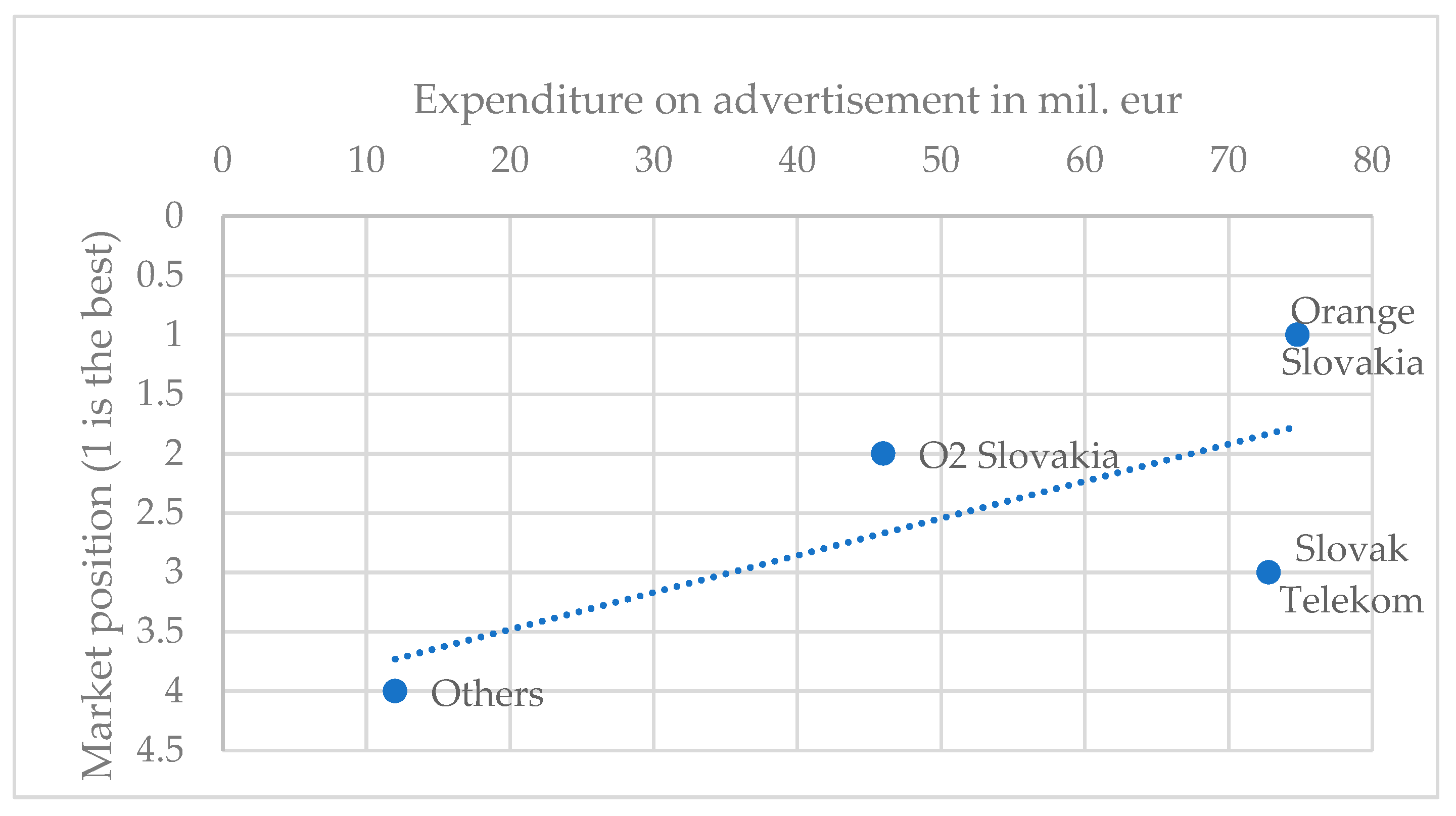
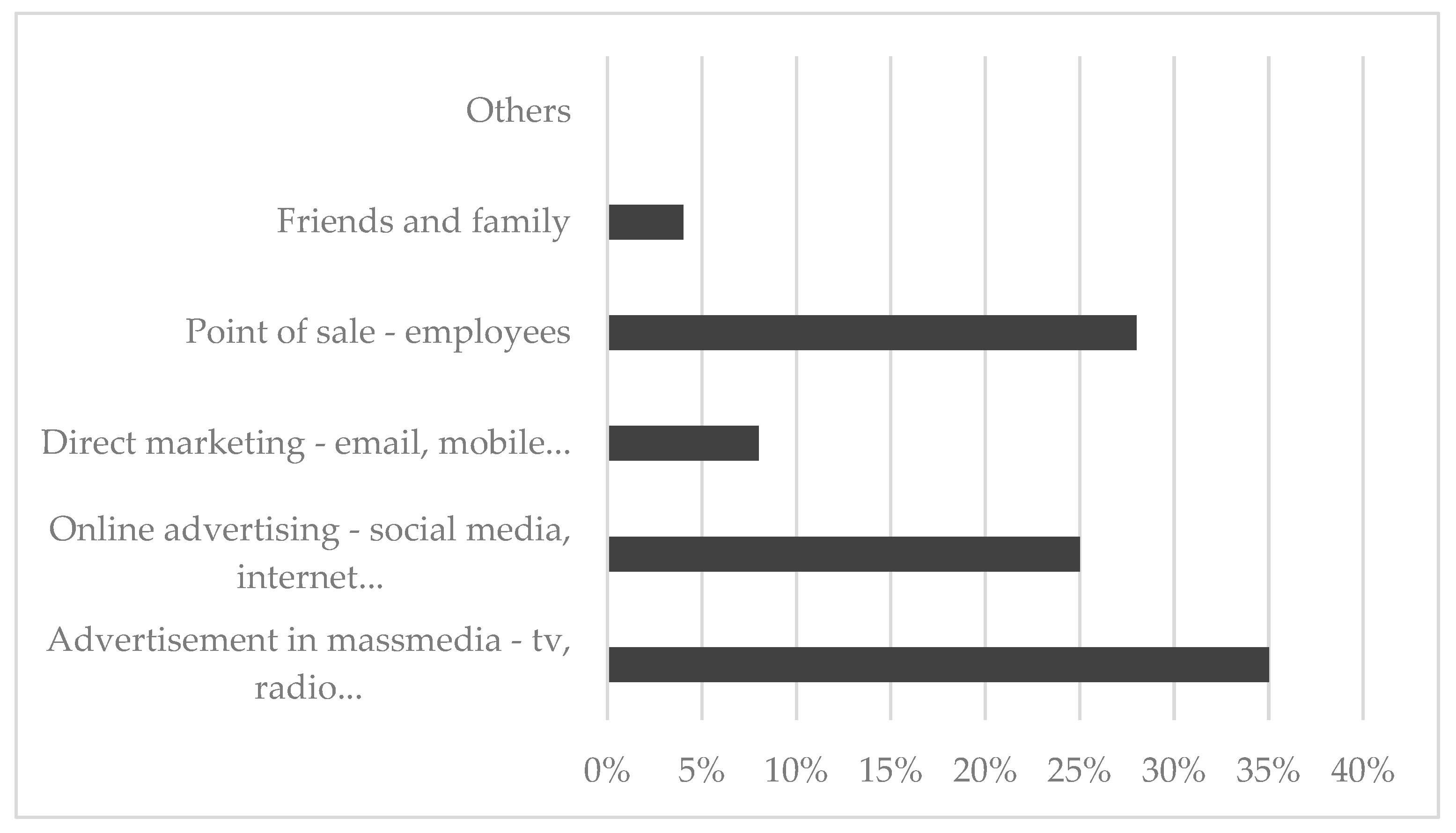

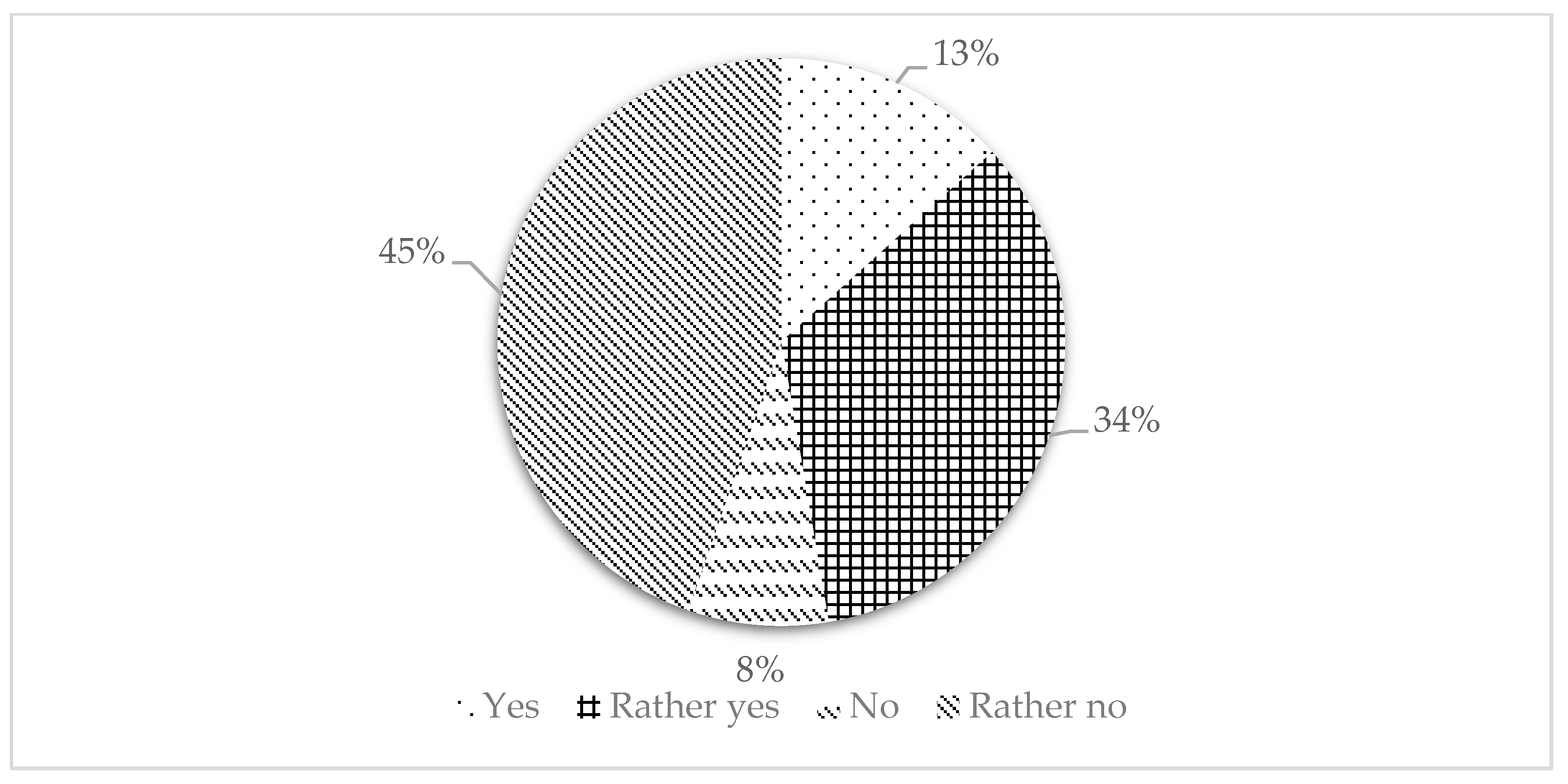
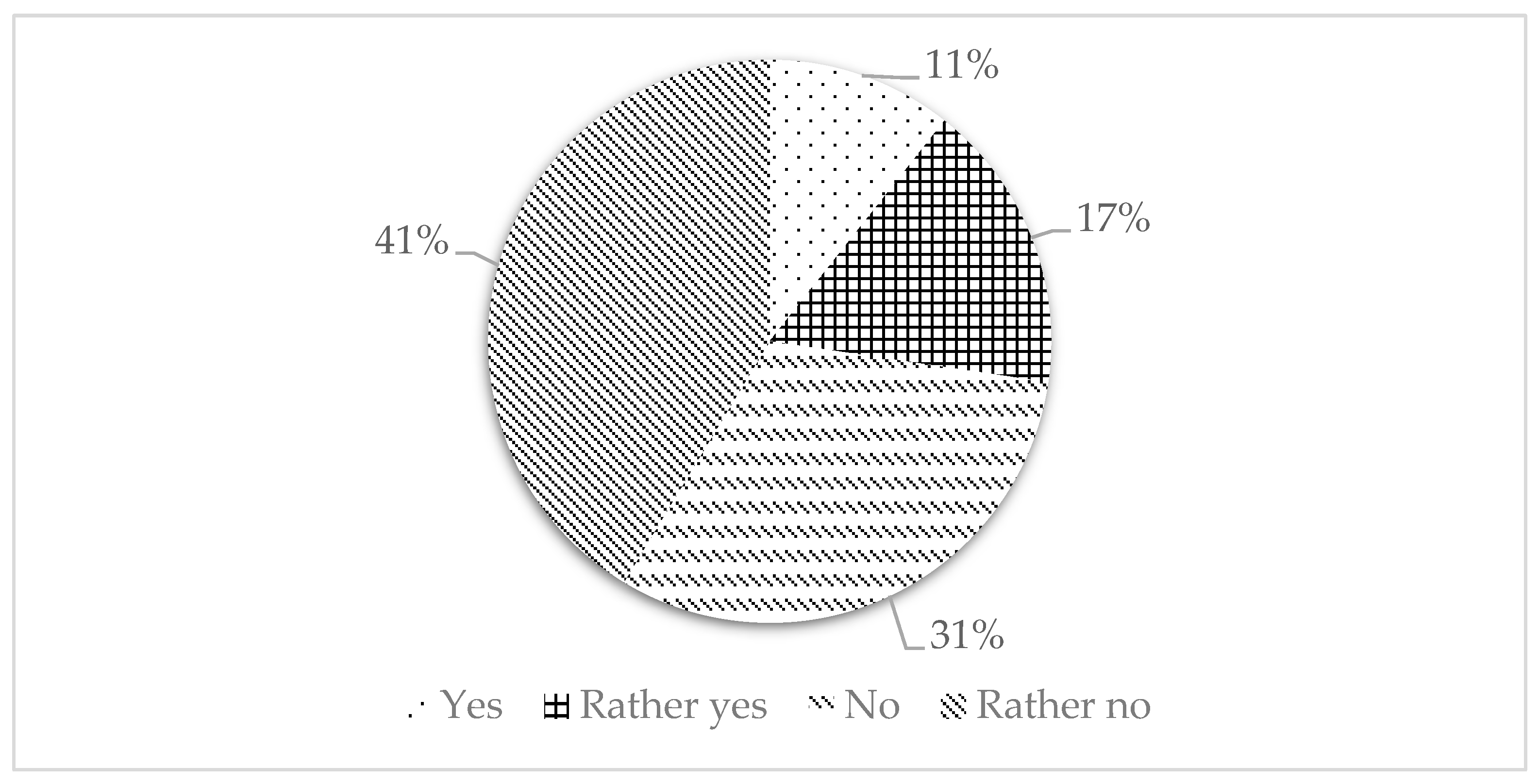
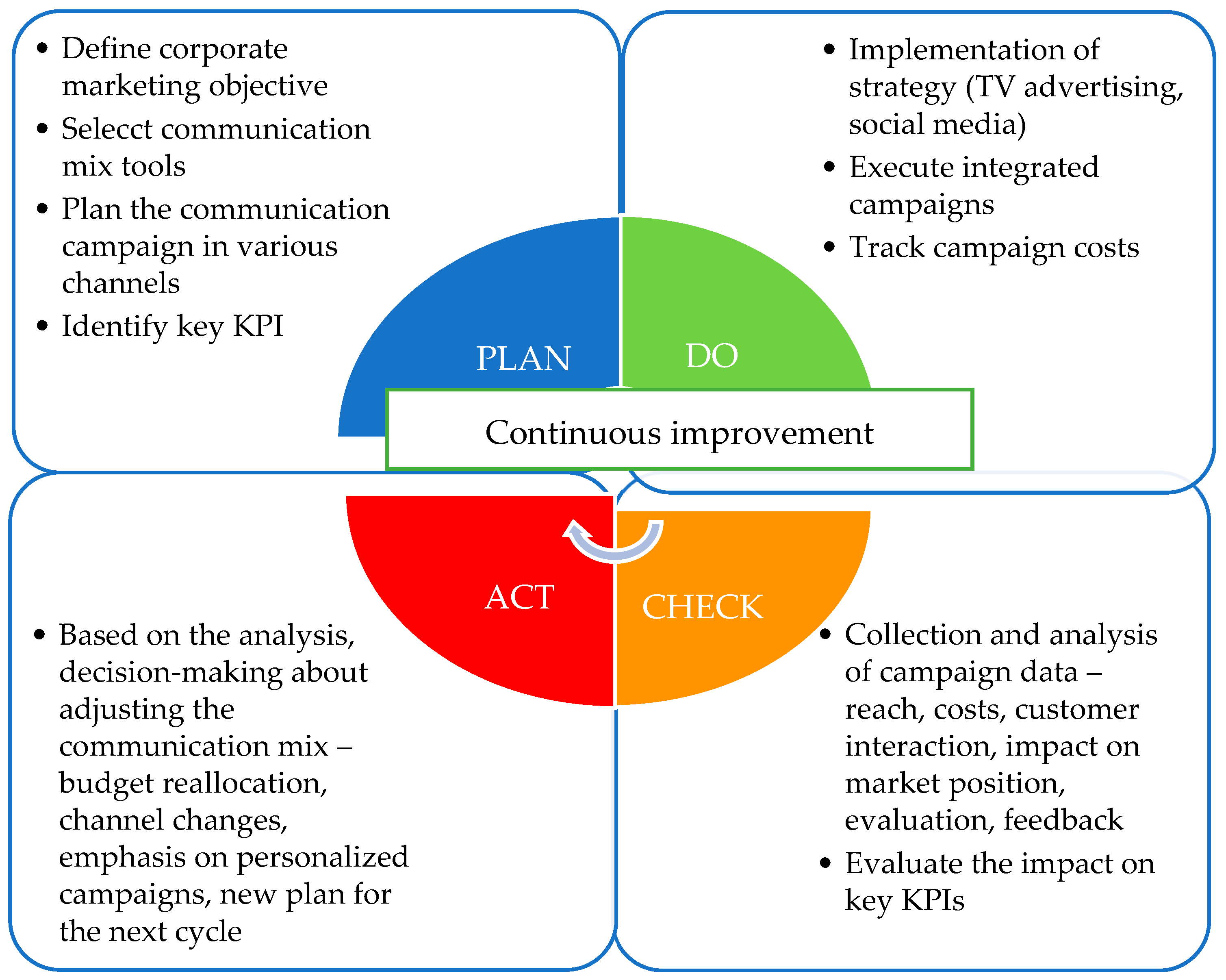
| Advertising | Sales Support/Sales Promotion | Direct Personal Communications | Public (Media) Relations | Service Access Points | Corporate Design and Brand Presentation |
|---|---|---|---|---|---|
| Broadcast media—adverts via television and radio Press/printed channels—newspaper and magazines Outdoor advertising—billboards, posters Direct/targeted marketing campaigns Online/digital marketing via online platforms | Product free Sampling Vouchers and coupons for future purchase Free gifts, complimentary items, giveaways Sign up for loyalty (reward) schemes Cash-back offers, rebates Price offers and discounts | In-person selling—face to face Telemarketing—phone based communication Trainings, educations, workshops, seminars. Trade shows and exhibitions Word of mouth, recommendations Online communication via social media and platforms and online communities | Press releases/kits/media statements Press conferences, meetings and briefings Hosting special public and stakeholders events Sponsorships and supporting events Thought leadership content and expert opinions Coverage in both traditional and online media | Physical service points for customers Staff/employees in frontline Self-service points and automated kiosks Company’s websites, digital portals and mobile apps Brochures with detailed information FAQs with the answers on them | Business signage and logo Décor, furnishing, equipment and interior design reflecting corporate style Vehicles branding Corporate uniforms and standardized employee dress code |
| Research Questions | Hypothesis 0 | Hypothesis |
|---|---|---|
| RQ1: What is the impact of social media use and online marketing activities on brand perception and position? | H0: There is no relationship between the level of interaction on social networks and the company’s market position. | H1: A higher average monthly engagement rate on social media increases a company’s market share. |
| RQ2: Is the level of investment in advertising linked to a higher market share for telecommunications companies in Slovakia? | H0: There is no relationship between marketing investment and market share | H2: The higher the annual advertising investment, the higher the company’s annual percentage market share. |
| RQ3: Which marketing communication channels have the most significant influence on customers’ purchasing decisions? | H0: Personal recommendations from employees have no greater influence on the final purchasing decision than traditional television advertising. | H3: Employee recommendations have a greater influence on purchasing decisions than television advertising. |
| RQ4: Which marketing communication channels are most preferred by customers? | H0: The share of customers who prefer direct personal channels is no higher than 50%. | H4: More than 50% of customers prefer direct personal communication channels over impersonal channels when making purchasing decisions. |
| Phase | Objective | Data/Research | Data Collection | Methods of Analysis | ||
|---|---|---|---|---|---|---|
| 1. | Strategic | Define the position in the market and compare the marketing communication activities used by the most significant competitors. | Qualitative/Quantitative/Secondary/Primary | Surveys conducted, annual reports | RQ1, H1 | Content analysis, Comparative analysis Statistical method: Spearmans Correlations, Pearson’s Correlation Descriptive statistic |
| RQ2, H2 | ||||||
| 2. | Analytical | Analyse the influence of the communication mix tools on the customers’ behaviour and brand perception. | Quantitative/Primary | Questionnaire Survey | RQ3, H3 | Chi-square testing Descriptive statistic |
| Implementation | Evaluate customer preferences and select the most effective tools for campaign implementation. | Quantitative/Primary | Questionnaire Survey | RQ4, H4 | Binomial testing |
| Company | Followers | Change | Interaction | Activity |
|---|---|---|---|---|
 Orange | 30,055,722 | −61,811 (−0.21%) |  7252 7252Comments: 2872 Shares: 971 Total: 11,095 | Links: 9 Videos: 18 Photos: 74 Total: 101 |
 Telekom | 232,646 | −224 (−0.1%) |  10,094 10,094Comments: 6473 Shares: 983 Total: 17,550 | Links: 9 Videos: 29 Photos: 34 Total: 72 |
 O2 SK | 221,179 | −14 (−0.01%) |  22,162 22,162Comments: 21,287 Shares: 2891 Total: 46,340 | Links: 18 Videos: 5 Photos: 38 Total: 61 |
 4 ka | 69,581 | +1341 (+1.93%) |  36,532 36,532Comments: 8862 Shares: 1958 Total: 47,352 | Links: 31 Videos: 10 Photos: 142 Total: 183 |
| Company | Advertising Expenditure | Allocated to TV Advertising | Ranked Based on Spending on Advertising | Market Position |
|---|---|---|---|---|
| Orange Slovakia | 74,808,086 | 99.3% | 1 | 1 |
| Slovak Telekom | 72,842,752 | 97.9% | 2 | 3 |
| O2 | 45,970,424 | - | 3 | 2 |
| Others | <12,000,000 | - | 4 | 4 |
| Minimum | Maximum | Mean | Median | Std. Deviation | |
|---|---|---|---|---|---|
| Advertisement expenditure (EUR) | 1.200 × 107 | 7.481 × 107 | 5.141 × 107 | 5.941 × 107 | 2938 × 107 |
| Followers | 69,581.000 | 3.006 × 107 | 7.645 × 106 | 226,912.500 | 1.494 × 107 |
| Interactions | 11,095.000 | 47,352.000 | 30,584.250 | 31,945.000 | 18,965.966 |
| Number of company activities | 61.000 | 183.000 | 104.250 | 86.500 | 55.145 |
| Minimum | Maximum | Mean | Median | St.dev | |
|---|---|---|---|---|---|
| Employees | 16.000 (11.000%) | 53.000 (35.000%) | 37.500 (25.000%) | 40.500 (27.000%) | 15.503 (10.066%) |
| Advertising | 12.000 (11.000%) | 67.000 (45.000%) | 37.500 (25.000%) | 35.500 (23.500%) | 25.878 (17.455%) |
| Influencers | 16.000 (11.000%) | 62.000 (41.000%) | 37.500 (25.000%) | 36.000 (24.000%) | 20.889 (13.565%) |
| Hypothesis | Tested Variables/Relationship | Methods Used | Result | Statistical Indicators | Conclusion |
|---|---|---|---|---|---|
| H1 | Relationship between the level of interaction on social media and the company’s market position | Correlation analysis (Pearson correlation coefficient) | Positive correlation confirmed | r = 0.67; p < 0.01 | Hypothesis confirmed |
| H2 | Relationship between the volume of marketing investments and market share | Linear regression analysis | Significant positive relationship | R2 = 0.54; p < 0.05 | Hypothesis confirmed |
| H3 | Influence of personal employee recommendations vs. traditional advertising on customer decision-making | Comparison of means (t-test) | Significant difference in favour of personal recommendations | t = 2.89; p = 0.004 | Hypothesis confirmed |
| H4 | Customer preference: digital vs. traditional channels | Descriptive statistics, comparison of means | Higher preference for digital channels | 68% of respondents prefer digital; p < 0.05 | Hypothesis confirmed |
| Recommended Activity | Activity Based on the Study | Hypothesis Verified | |
|---|---|---|---|
| Strategic | Define communication objectives aligned with corporate goals, identify target customer segments, and select the most suitable communication tools to achieve these objectives. | Define the company’s market position and compare the marketing communication strategies of key competitors. | The level of marketing investment and market position have a positive correlation. The level of interactions on social media and market position have a negative correlation. |
| Analytical | Collect and analyse data on market trends, campaign performance, costs, and communication effectiveness. | Analyse the impact of communication mix tools on customers’ behaviour and brand perception. | Personal recommendations from employees have a greater impact on customer decision-making than advertising in the media, when implemented as part of a strategy. |
| Implementation | Execute the communication campaign and make tactical and operational adjustments based on feedback and results. | Evaluate customer preferences and identify the most effective tools for campaign implementation. | Leaders’ customers prefer non-personal communication. |
| Step | Question | Recommended Action |
|---|---|---|
| Plan | Do we know which channels our customers prefer? | Survey customer preferences (e.g., questionnaire, interaction analysis). |
| Do | Are campaigns tailored to the target audience? | Segment customers by age and behaviour and select the appropriate channels. |
| Check | Do we measure the impact of individual channels? | Track metrics such as engagement, conversion, and ROI at the level of each tool. |
| Act | Do we tailor campaigns based on results? | Optimise your budget based on effectiveness and customer feedback. |
| Leaders | Others | |
|---|---|---|
| Marketing communication orientation | Broader customer base, more financial resources, and comparison with the competition of the largest market leaders | Focus on a specific segment, and make an effective investment. |
| Plan | Mass communication campaign plan | Personalised communication campaign plan |
| Do | TV advertising with higher investment | Communication via social media, higher interaction, and higher influence of activities |
| Check | Market research, influence of TV advertisement, number of new customers acquired, volume of up-selling and cross-selling | Customer reviews and satisfaction on social media, satisfaction via survey, and increasing customer value |
| Act | Content change of campaigns, re-evaluation of investment used, re-evaluation of communication mix used | Change in investment, increase/decrease in the volume of interactions on social networks, personalised campaigns |
| Goal | Christmas Campaign 2023 |
|---|---|
| Plan | Preparation of a Christmas campaign focused on promoting the company’s values and addressing social issues, specifically, highlighting inclusion and diversity under the theme “Respect.” Measurable objectives and campaign budget were defined. |
| Do | Launch of the campaign—TV commercial featuring various types of families and situations during Christmas dinner. |
| Check | Continuous monitoring and evaluation of the campaign—the company tracked public reactions, social media discussions, the ratio of positive to negative feedback, and overall media coverage. Findings—public opinion was polarised—some viewers praised the ad, while others criticised it, considering it inappropriate and calling for its withdrawal. |
| Act | In response to the feedback, the company issued a public statement to clarify the campaign’s message, adjusted the tone of communication, and ultimately withdrew the commercial from broadcast. |
| PDCA Phase | Key Managerial Actions | Example of Questions for Process Tracking | Recommended Activity |
|---|---|---|---|
| Plan | Define objectives, target audience, and allocate budget | What are the goals of the campaigns? Who are we trying to reach? How will the resources be distributed? | Conduct market research—Analyse customer behaviour. Define KPIs and success metrics. Create a campaign brief. |
| Do | Execute the communication strategy | Are messages tailored to the audience? Are all communication tools in place? Are the messages conveyed clear and concise? | Develop content and creative materials. Coordinate internal teams, employee training and motivating. Launch campaign through selected channels. |
| Check | Monitor and evaluate campaign performance | Are engagement and reach meeting expectations? What is the tone of public response? | Track analytics (e.g., impressions, comments, interactions) on social media. Conduct sentiment analysis. Monitor social media and media coverage. Monitor audience reactions and customer satisfaction. |
| Act | Adapt strategy based on feedback and performance | What adjustments are needed? Should the budget or message be changed? | Revise the campaign based on data. Reallocate budget it necessary. Issue public statement or clarification. Update internal communication guidelines. Campaign withdrawal. |
Disclaimer/Publisher’s Note: The statements, opinions and data contained in all publications are solely those of the individual author(s) and contributor(s) and not of MDPI and/or the editor(s). MDPI and/or the editor(s) disclaim responsibility for any injury to people or property resulting from any ideas, methods, instructions or products referred to in the content. |
© 2025 by the authors. Licensee MDPI, Basel, Switzerland. This article is an open access article distributed under the terms and conditions of the Creative Commons Attribution (CC BY) license (https://creativecommons.org/licenses/by/4.0/).
Share and Cite
Řepová, M.; Lendelová, L.; Lendel, V. A PDCA-Based Decision-Making Framework for Sustainable Marketing Communication Strategies: A Case Study of a Slovak Telecommunications Company. Systems 2025, 13, 721. https://doi.org/10.3390/systems13080721
Řepová M, Lendelová L, Lendel V. A PDCA-Based Decision-Making Framework for Sustainable Marketing Communication Strategies: A Case Study of a Slovak Telecommunications Company. Systems. 2025; 13(8):721. https://doi.org/10.3390/systems13080721
Chicago/Turabian StyleŘepová, Miroslava, Lucie Lendelová, and Viliam Lendel. 2025. "A PDCA-Based Decision-Making Framework for Sustainable Marketing Communication Strategies: A Case Study of a Slovak Telecommunications Company" Systems 13, no. 8: 721. https://doi.org/10.3390/systems13080721
APA StyleŘepová, M., Lendelová, L., & Lendel, V. (2025). A PDCA-Based Decision-Making Framework for Sustainable Marketing Communication Strategies: A Case Study of a Slovak Telecommunications Company. Systems, 13(8), 721. https://doi.org/10.3390/systems13080721






